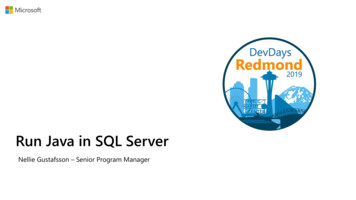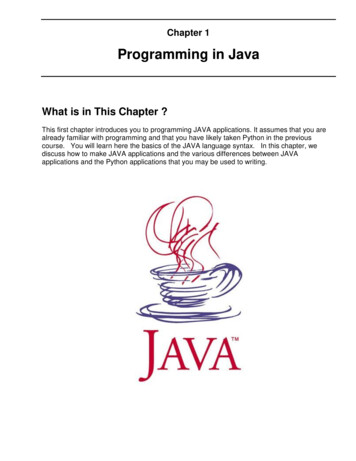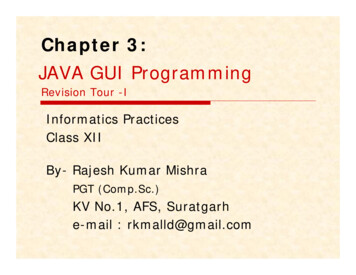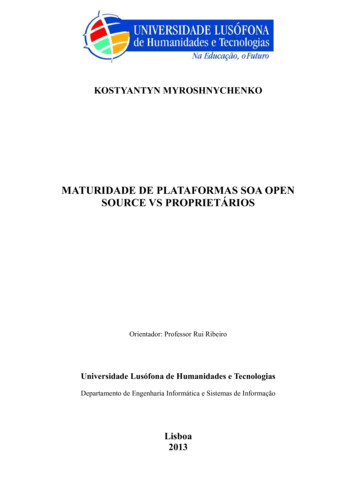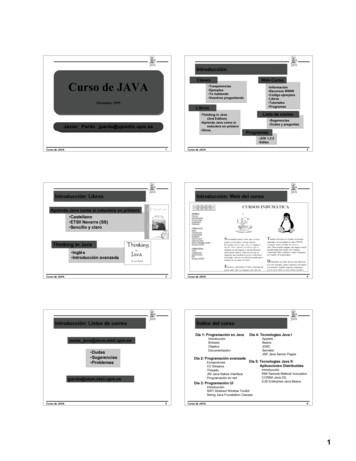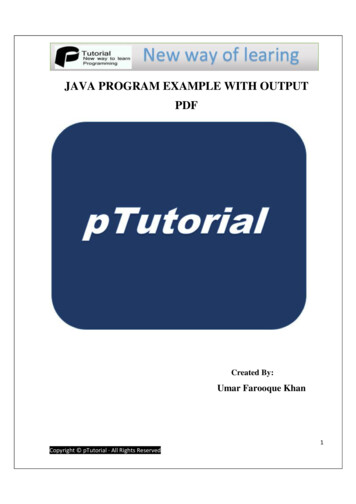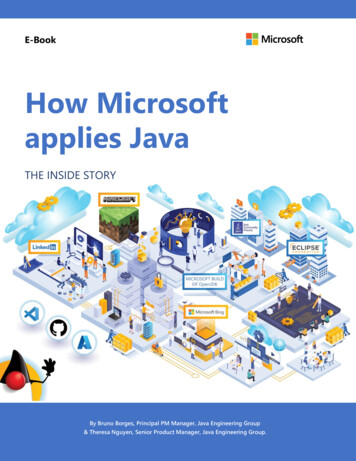
Transcription
E-BookHow Microsoftapplies JavaTHE INSIDE STORYBy Bruno Borges, Principal PM Manager, Java Engineering Group& Theresa Nguyen, Senior Product Manager, Java Engineering Group.
About the authorsBruno Borges is a Principal PM Manager in theJava Engineering Group at Microsoft. He joinedthe company in 2018 after a six-year career as aProduct Manager for Java related technologiesat Oracle, and later-on in a DeveloperEngagement and Experience role on OracleCloud. Bruno has been involved in Javadevelopment and the Java community since2001.Theresa Nguyen is a Senior Product Managerin the Java Engineering Group at Microsoft. Shejoined the company in 2018 after ten years atCaucho Technology and Tomitribe, two Java EEapplication server vendors. Theresa has beeninvolved with Java and the Java communitysince 2008. 2022 Microsoft Corporation. All rights reserved.This document is provided “as is.” Information and views expressed in this document, including URLand other internet website references, may change without notice. You bear the risk of using it.This document does not provide you with any legal rights to any intellectual property in any Microsoftproduct. You may copy and use this document for your internal, reference purposes.
How Microsoft applies Java01 /Introduction Page 402 /The evolution of Java at Microsoft Page 503 /Committed to developers and the Java community Page 6 Microsoft Build of OpenJDK Tools for the Java developer Eclipse Foundation and Java Community Process Strategic partnerships: VMWare, Red Hat, IBM, Oracle and more04 /Developer and customer success is our success Page 9 Improvements in technologies, services, and tooling Empowering our customers to run and scale their Java apps05 /We rely on Java. And use it. A lot. Page 11 Bing Azure Infrastructure Control Plane LinkedIn Yammer Minecraft Java Edition06 /Committed to continuous improvement Page 1507 /Talk to us Page 16
How Microsoft applies JavaThe Developer’s Guide to AzureIntroductionsOver the last decade, we’ve witnessed Microsoft’s evolution from a focus on Windows and .NET toa mindset that embraces open-source software and philosophy. Today, Microsoft employsthousands of people focused on Java across engineering, developer relations, customer support,and other parts of the business.When we talk to customers and developers, we’re often surprised at how so many are unaware ofthe extent to which Microsoft applies, implements, and supports Java:1.We use Java. A lot. We’re using Java to run major parts of Microsoft—and empowerthousands of customers to do the same.2.We’re listening to feedback from the Java developer community and making meaningfulcontributions to existing community frameworks.3.Our teams across Microsoft employ thousands of Java professionals who innovate andintegrate Java into Microsoft products and technologies and empower Java developers to domore.In this paper, we’ll look at: A historical look at the ways in which Microsoft has adopted Java over the years. The recent history of Microsoft’s investments in Java. What we’re doing today to help Java developers succeed. How various groups within Microsoft are using Java internally.43
How Microsoft applies JavaMicrosoft opens up to open sourceStarts investing in Java resources and expertise2008 2009 Microsoft Bing, the company’s search engine is deployed across multiple datacenters, spanninghundreds of thousands of JVMs on more than 50,000 servers.Starts building 1st class support for Java on Microsoft Azure.Microsoft commits to shaping Azure as an open platformMakes additional investments in Java partnerships20112013 Commits to shaping Azure as an open platform.Azure becomes the first major cloud platform with included OpenJDK commercial support.Microsoft Azure’s transformation to an open platform gains rapid momentumunder Nadella’s leadership2014201520162018 Releases Azure Toolkit for Eclipse.Releases Azure Toolkit for IntelliJ.Releases support for Java on Azure App Service.Partners with Pivotal/VMWare around Spring and Azure.Microsoft joins Eclipse Foundation.Releases scalable services for open-source databases: MySQL, PostgreSQL, MongoDB, CassandraMicrosoft and Java - in it for the long term.2019202020212022 Acquires jClarity, the leading contributor to the AdoptOpenJDK project.Releases Azure Spring Apps in collaboration with VMware.Releases Red Hat JBoss EAP support for Java EE on Azure App Service.Becomes founding member of the Eclipse Adoptium Working Group.Releases Microsoft Build of OpenJDK.Microsoft joins the Java Community Process (JCP) program.2 million JVMs run in production on internal systems across Microsoft.Microsoft joins the Eclipse Jakarta EE and MicroProfile Working Groups.Releases Apache Tomcat 10 and Java 17 support on Azure App Service.“Microsoft’s positive approach towards open-source ecosystems and specifically towards Javademonstrates their unbridled passion for enabling developers to achieve more. At jClarity, ourteam was focused on the good of the overall Java open-source ecosystem via theAdoptOpenJDK project, supporting Java User Groups, and helping developers better understandJava performance. After being acquired by Microsoft, our efforts to empower the Javacommunity have gained even more momentum and we are incredibly proud to be part of whatis now a Java at Microsoft steam train!”-- Martijn Verburg, Principal Group Engineering Manager - Java Engineering Group, Microsoft5
How Microsoft applies JavaCommitted to developersand the Java communityMicrosoft actively supports Java community organizations to help promote the future of Java, including ongoingdevelopment of the Java language and the JVM. Let’s take a closer look at the ways in which Microsoft contributes tothe Java community’s work as part of our commitment to the success of Java Developers.Microsoft Build of OpenJDKReleased in mid-2021, the Microsoft Build of OpenJDK is based on the OpenJDK source code, built using EclipseAdoptium build scripts, tested with Eclipse Adoptium AQAvit, and certified with Oracle's JCK (Java Compatibility Kit)for long-term supported versions. Today, it includes binaries for Java 11, and Java 17 on x64 environments onmacOS, Linux, and Windows, AArch64/ARM64 on Linux and Windows, binaries for macOS on Apple Silicon (ARM64),and musl-libc compiled binaries for Alpine Linux on x64.The Microsoft Build of OpenJDK is a drop-in replacementfor other builds of OpenJDK. We built it to support bothour internal Java workloads and the significant growthwe’re seeing in the number of Java-based customerworkloads on Azure. In addition, running our own buildgives us a deeper connection with the Microsoft teams thatoperate various Azure services that support Java, enablingus to work more closely together in addressing bugs,performance regressions, and other issues that matter toour customers. We also see our own build of OpenJDK asan avenue for even more active participation in the Javaecosystem and increased contribution to the Javacommunity.6
How Microsoft applies JavaTools for the Java developerWe’re constantly listening to feedback from the community and work closely with other teams at Microsoft to deliverthe tools that Java developers need and love.In November 2021, Red Hat released version 1.0 of the Language Support for Java on Visual Studio Code, a multiyear collaboration between Microsoft, Red Hat, and the Java community. This release includes a series of changes,including the stability that the more than 1 million Java developers who use Visual Studio Code have come to expect.Other highlights in the release include Java 17 support.In parallel, we’re working closely with GitHub teams to ensure great support for Java, such as GitHub Codespaces forJava and the ability to use Java in GitHub Actions.The Java developer community also really enjoys the ease of IntelliJ Azure Toolkit. Azure also works seamlessly withother tools such as Maven, Gradle, Eclipse Toolkit, etc.Eclipse Foundation and Java Community ProcessIn August 2021, we expanded our participation in the Eclipse Foundation to the role of Strategic Member. Todaywe’re actively participating in Eclipse Adoptium and other projects hosted by the foundation, including the EclipseJakarta EE, MicroProfile, IDE and others. A full list of the Eclipse projects to which Microsoft is actively contributingcan be found on the Eclipse Foundation website.In November 2021, we took another major step when Microsoft officially joined the Java Community Process (JCP).For the past 20 years, JCP has served as the mechanism for collaboration between individual developers, customers,and vendors in developing standard technical specifications for Java to ensure stability and cross-platformcompatibility.Strategic partnerships: VMWare, Red Hat, IBM, Oracle, and moreOver the past few years, we’ve forged several strategic partnerships with major vendors in the Java ecosystem. Thesepartnerships empower developers to code and deploy without worrying about infrastructure.Azure Spring Apps, a fully managed service, was jointly developed by Microsoft and Pivotal / VMWare. It abstractsaway the complexity of managing infrastructure and Spring Cloud middleware, enabling Java developers to focus onbuilding cloud-native applications while Azure takes care of dynamic scaling, security, high availability, and so on.Azure Spring Apps also offers native integrations with third-party application performance monitoring (APM) toolsfrom New Relic, App Dynamics, Dynatrace, and Elastic.7
How Microsoft applies JavaNext, we partnered with Red Hat to deliver Red Hat JBossEnterprise Application Platform (EAP) on Azure App Service- enabling Java developers to deploy their Java EE andJakarta EE applications into Azure App Service withintegrated support from both companies. JBoss EAP is alsoavailable on Virtual Machines and Virtual Machines ScaleSet - through Azure Marketplace mages, for fastdeployment and horizontal scaling of Java clusters.We also partnered with IBM and Oracle, launching jointlydeveloped solutions for WebSphere Application Server,WebSphere Liberty, and Open Liberty on Azure and forOracle WebLogic Server on Azure VMs and on AzureKubernetes Service. Finally, in terms of recent partnerships,we worked with Confluent Cloud to help them deliverApache Kafka for Confluent Cloud, an Azure Marketplaceoffering that provides Apache Kafka as a fully managed service."In 2009, we embarked on the journey to enable Java on Azure and Java has since been anunstoppable force at Microsoft. Today, Azure is the home for thousands of mission-critical,enterprise Java workloads scaled across the globe; the implementations help us learn sowe can help developers and customers achieve more. We are grateful for how far we havecome and for where we are heading in terms of meeting the needs of Java developers. Iam super thrilled to have been a part of this journey since 2009 and I am energized bywhat lies ahead."-- Asir Selvasingh, Principal Architect for Java on Microsoft Azure8
How Microsoft applies Java9Developer and customersuccess is our successJava developers can use a wide range of development and DevOps tools—including Visual Studio Code, IntelliJ, GitHub,Maven and Gradle—to bring their Java apps to the cloud while collaborating effectively and saving time and money.Microsoft has offerings that are jointly developed and supported with its partners to allow developers to keep usingtheir favorite frameworks, tools, and services while benefiting from all that the Azure cloud has to offer.Our engineers and support teams work closely with our customers to effectively run and scale their Java apps. Customersuccess stories, options for customer support, and consistent programming of technical content on Java are all waysMicrosoft helps developers succeed.Improvements in technologies, services, and toolingIn addition to our solutions, we work to provide our customers with access to information and resources that helpensure their success. At a high level, those efforts can be broken down into three main areas: Supported Azure services that customers can easily consume—such as Azure App Service, Azure Spring Apps, andothers. Developer tools and services for Java developers —such as the Microsoft Build of OpenJDK, Java extensions for VisualStudio Code, Azure SDK, Spring Cloud Azure libraries, GitHub, Playwright, etc. Documentation and support—such as the Microsoft for Java Developers documentation center, Azure docs for Javadevelopers and Microsoft Learn.Empowering our customers to run and scale their Java appsOver the past several years, thousands of Microsoft customers have moved to Java on Azure, including well-knowncompanies like Adobe, AIA, Bosch, Daimler, FedEx, J.B. Hunt, Kroger, Maersk, Mercedes Benz, and Swiss Re. We’veworked closely with many of these customers, working side-by-side with their engineers to ensure success. Similarly, wework closely with the internal groups at Microsoft who use Java, lending our own expertise while learning from theirs.Through such efforts, we’ve amassed a substantial body of insight and expertise toward helping new customers buildJava applications on Azure or move existing ones to the cloud—including, for example, how moving to the latestversions of Java can help increase performance and reduce costs.
How Microsoft applies JavaFedEx launched a platform that dynamically predictsestimated time of arrival on more than 16 million shipments a day“We are committed to Java and are helping organizations modernize their Javaapplications with Java Spring Apps Enterprise, which we built as part of our expansivepartnership with VMWare. FedEx, for example, is using the service to run all their Javaapps at massive scale, predicting the arrival time of millions of shipments.”-- Satya Nadella, CEO, Microsoft“Exposure and consumption of these insights are critical [for our business], and wechose Azure Spring Apps as our principal compute for high-volume processing becauseof its ease of use, scale, and integrations into the Azure ecosystem. Our collaborationwith Microsoft and VMware has delivered an amazing service for fast-moving Javateams to deliver impactful solutions for our customers."-- Tony Kreager, Senior Vice President, Data Engineering & Data Science, FedEx DataworkMercedes-Benz R&D creates ‘container-driven cars’powered by Microsoft Azure“The Azure ecosystem gave us useful capabilities that the developers worked into theirsystem, such as Azure Container Registry tasks, AKS integration, alerting, monitoring,and logging. Plus, Azure Pipelines made it possible to handle deployment and othertasks in a repeatable way, giving the platform team centralized control and standardsenforcement.”-- Rodrigo Nunes, Principal Software Engineer, Mercedes-Benz R&D10
How Microsoft applies Java11We rely on Java.And use it. A lot.Microsoft uses Java extensively. We’re using Java to run significantparts of Microsoft—and empower thousands of customers to dothe same. After the acquisition of jClarity in 2019, we kicked off adedicated effort to optimize internal Java workloads andcontribute our learnings to OpenJDK.Today, we now have more than 2 million JVMs running inproduction on internal systems across the company. Wecollaborate closely across various businesses at Microsoft, sharingbest practices, lessons learned, and expertise running Java inenterprise scenarios and funneling insights back into ourcustomer-facing offerings as well as our contributions to thebroader Java community.BingPeople are often surprised to hear that Bing—Microsoft’s web search engine, which also powers the search feature in theWindows Start menu—uses Java. In 2016, with machine learning (ML) and deep learning (DL) being incorporated into theBing search stack, the offline compute team at Bing began building a platform that could support both big dataprocessing and ML/DL workloads.Today, that offline compute platform is based on Apache Kafka and Apache Hadoop, with data processing driven byApache Spark jobs running in JVMs. Most of the environment is currently based on Java 8, with the remainder runningJava 11. The platform is deployed across multiple Bing datacenters, spanning hundreds of thousands of JVMs on morethan 50,000 servers. About 40 percent of the JVMs run on bare metal, while the other 60 percent run on Azure VMs.Cluster management is based on Yarn, with HDFS used for distributed file storage.The Bing engineering team has hundreds of Java developers, with about half using IntelliJ and the other half using VisualStudio Code. Today, across Bing, more and more “old” big data processing is being migrated to the new platform, withboth batch and stream processing running on Java VMs.If you’d like to learn more about Bing’s use of technology, check out the Bing Engineering blog.
How Microsoft applies Java12Azure Infrastructure: Control PlaneWhen we tell customers that while provisioning resources, most of the interactions that they have with Azure go througha JVM, they’re caught by surprise. This is due to Azure Control Plane operations within the Azure infrastructure, which areused to manage the resources within an Azure subscription—such as the creation of a virtual machine, storage account,or database. Two foundational services within the control plane include a pub/sub messaging service built on ApacheKafka and a leader election/configuration management service built on Apache ZooKeeper. These control plane servicesrun on bare-metal servers in every Azure datacenter, of which there are more than 160 today.Both services are written in Java and Scala, and run on the JVM. The pub/sub service built on Kafka uses the MicrosoftBuild of OpenJDK 11 today, and the leader election/configuration management service based on Zookeeper uses EclipseTemurin 8. After tuning exercises performed by our Java Engineering Group and the Control Plane teams, they have optedto use the G1GC garbage collector for both services.Across all Azure datacenters worldwide, these Kafka clusters for the pub/sub service in Azure infrastructure produce morethan 500 billion messages and more than 200 terabytes of data every day.LinkedInWhen Microsoft acquired LinkedIn in 2016, it also acquired a huge Java shop. More than 46 percent of all LinkedIn sourcecode is written in Java, with more than 43 million lines of Java code contained in more than 400,000 files. About 60percent of all LinkedIn engineers are Java developers, using Java tools such as Eclipse, IntelliJ, and Visual Studio Code.Almost all production services at LinkedIn run within a Java Virtual Machine (JVM). Altogether, the company’s threeproduction datacenters host hundreds of thousands of JVMs, with some 60 percent running Java 11 while the rest runJava 8. Today, close to 90 percent of all JVMs are running the Microsoft Build of OpenJDK, which is discussed in detaillater in this eBook. Those JVMs run a range of server technologies, including Jetty ( 55%), Play Framework ( 25%), andApache Samza ( 20%). LinkedIn also employs several garbage collectors, including G1 ( 55%), CMS ( 30%), Parallel GC( 5%), and others.In the past, LinkedIn had a monolithic architecture. Today, it’s fully microservices-based, with more than 2,000 Javamicroservices—a number that’s growing every day. Key microservices within the company’s architecture include: A service that drives the “People you may know” feature of LinkedIn, which has the largest heap across all back-endservices at LinkedIn, at 1.2 TB. A service for the LinkedIn member-to-member blocking feature, which supports more than 2,000 queries per secondper instance. It’s one of the lowest tail-latency services across all back-end services at LinkedIn, at 99.9 percent 1millisecond.
How Microsoft applies Java 13A routing service-layer for LinkedIn’s own distributed, fault-tolerant NoSQL database, called Espresso. Its 4,500production instances support a total of more than 22 million queries per second.Over the years, LinkedIn has built several in-house Java solutions to drive its data pipeline, many of which are open-sourceand are used by Java developers worldwide. Apache Kafka, LinkedIn’s pub/sub messaging system, is one such example, withthe company’s Kafka cluster producing more than 5 trillion messages and handling more than 5 petabytes of data per day.Apache Samza, the company’s distributed stream processing engine, processes over 1 trillion messages per day. ApachePinot—a distributed, real-time OLAP data store—and Espresso were also developed at LinkedIn.If you’d like to learn more about LinkedIn’s use of Java, check out the LinkedIn Engineering website.YammerYammer, an enterprise social networking platform, was acquired by Microsoft in 2012 and is now a fully integrated part ofMicrosoft Teams. The Yammer service is largely Java-based; some parts are written in Ruby, and the Yammer team islooking at adopting JRuby. The Yammer team has hundreds of Java developers, who use a mix of IntelliJ and Visual StudioCode.Yammer is powered by some 70 different microservices, which run on thousands of JVMs hosted on Linux machines. Mostof those JVMs are based on Eclipse Temurin (formerly AdoptOpenJDK) 8 and 11, with plans to move to the MicrosoftBuild of OpenJDK 17 soon. Elasticsearch clusters run on Ubuntu’s OpenJDK 8. Dropwizard—an open-source frameworkfor rapid development of REST APIs—was developed in-house at Yammer and is still deployed widely.Other open-source projects in use at Yammer include: Apache Kafka for asynchronous (pub/sub) inter-service communication Apache HBase and Apache Hadoop (hosted on Azure Databricks) for big data Apache Superset for visualization Apache ZooKeeper for consensus management across service mesh and PostgreSQL (master/read replica) clusterAltogether, the Yammer service supports up to 100,000 requests per second.
How Microsoft applies Java14Minecraft Java EditionAlthough Minecraft has been ported to many platforms, the original version of the game—now called Minecraft: JavaEdition—remains immensely popular. As the name suggests, it was written in Java and remains a Java desktop applicationto this day. Today, Minecraft: Java Edition bundles the Microsoft Build of OpenJDK 17 and reaches millions of gamersaround the world.Minecraft Realms, which are personal, Microsoft-hosted multiplayer Minecraft servers, are also based on Java—includingboth the personal servers themselves and the backend infrastructure that supports them. The personal servers reside withinephemeral VMs, which are Docker containers that wrap the Minecraft Realms Java service and the dedicated game server.Minecraft Realms runs more than 100,000 ephemeral VMs per day via Azure PlayFab, a fully managed platform for buildingand operating live games.Within each ephemeral VM, the Java service handles commands and input from the Minecraft client, communication withthe dedicated Minecraft game server, and communication with backend Minecraft Realms services for status, payments, andso on. There are typically 50-75 instances of such backend services, which are hosted on Azure VMs running Ubuntu Linux.Other services that support the backend infrastructure include Azure Service Bus for messaging, Azure Blob Storage forstoring hundreds of petabytes of large files, Geneva and Kusto for logging, and Grizzly for HTTP services. MySQL is used forall database needs, although the Minecraft Realms team is considering a move to Azure Table Storage and Azure CosmosDB.
How Microsoft applies JavaCommitted to continuousimprovementCommitting to developer and customer success is a continuousprocess, one that we take very seriously. Some of our key focus areasinclude: Listening to our customers who use Java—both external andinternal—and delivering what they tell us they need. Packaging the best practices and lessons learned from our effortsinto an easily accessible and consumable knowledge basedesigned for developer success. Working with the thousands of Java developers and Javachampions across our engineering and product teams towardimproving our Java products. Contributing to OpenJDK and engaging with the Java communitythrough the Eclipse Foundation, Eclipse Adoptium, Jakarta EE andMicroProfile Working Groups, Java Community Process, and the industry partnerships we’ve formed. Actively sponsoring, attending, and contributing to relevant industry events and conferences. Recruiting passionate, experienced Java professionals to join our product and engineering teams.“Microsoft's commitment to customer success starts with understanding what our customersneed. Through extensive customer engagement, we developed services specifically forcustomers with Java-based workloads, such as Azure Spring Apps for Spring Boot applications,a managed service offering for Red Hat JBoss EAP. To address customer requests for moreidiomatic and native Java support, we have incorporated that support across our entireportfolio: Azure services, SQL Server, Big Data, and developer tools.”-- Scott Hunter, VP of Engineering Product Management at Microsoft15
Talk to usIf you’d like to learn more about Java development at Microsoft our Javadocumentation home page is a good starting point. If you’re interested in divingdeeper into some of the subjects we’ve covered in this eBook, below are somehelpful sources of information:Blog articles, forums, and other ad-hocengagementBeyond the formal training and documentation venues described above, we also tryto keep Java developers informed on what we’re doing in more informal, ad-hocways. Blog articles are a good example, with the Java at Microsoft blog, TechCommunity Apps on Azure blog, and Azure Blog providing news, updates, andinsights for Java development across Microsoft tools, Azure services, and OpenJDK.We’re also on Twitter at @JavaAtMicrosoft.Training and technical enablementWe recently added a Get Started guide on Java on Azure on our online learningplatform, Microsoft Learn. We also recently launched a Java for Beginners channelon YouTube, where Microsoft employees from around the world are sharing theirknowledge of Java and all you can do with it.We have formal programs to help customers deploy Java on Azure, as well. Onesuch program is FastTrack for Azure, which customers can use to move their Javaapps to Azure quickly and efficiently, with customized guidance on architectures andbest practices from our own engineers. FastTrack engagements are free tocustomers with eligible Azure subscriptions, and typically last a few weeks.We’d love to hear your feedback. Please reach out to us via Twitter:@JavaAtMicrosoft.For more information on Java development visitdeveloper.microsoft.com/java
to keep Java developers informed on what we're doing in more informal, ad-hoc ways. Blog articles are a good example, with the Java at Microsoft blog, Tech Community Apps on Azure blog, and Azure Blog providing news, updates, and insights for Java development across Microsoft tools, Azure services, and OpenJDK.


